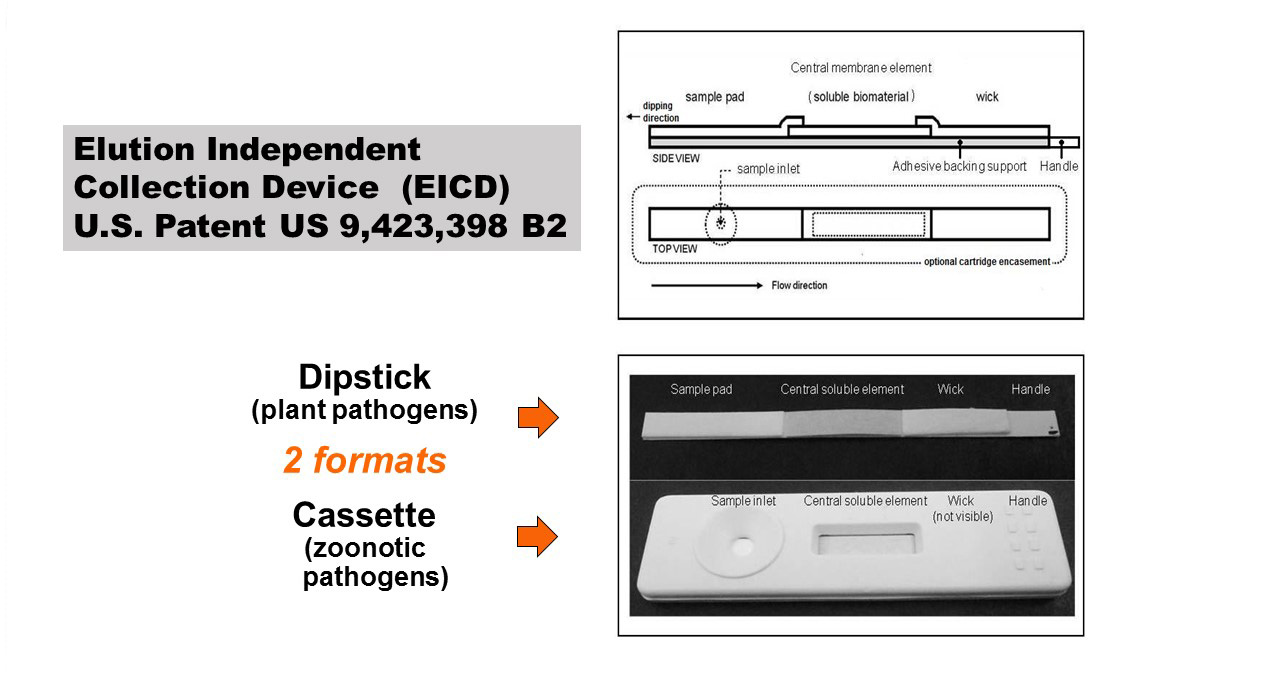Elution Independent Collection Device
Summary of Invention
Collecting and archiving nucleic acids (NA) are key steps in detection and diagnosis when using PCR for health, biosecurity, or microbial forensics applications. The existing paper-based technologies for collection offer advantages, such as storage of NA at room temperature. However, recovering NA using current technology requires few steps, and direct PCR is hampered by the residual paper matrix itself. This significantly limits its application in rapid disease diagnostics.
Patented elution-independent collection device (EICD) developed by researchers at Oklahoma State University is used for rapid collection of microorganisms and recovery of nucleic acids. The easy-to-implement EICD collects fluid specimens by contact and lateral flow. Minute pieces (1.2 mm diameter) of a built-in soluble element dissolve directly in commercial PCR mixtures without an intermediate elution step, thereby streamlining PCR based assays.The device collects fluidic specimens by contact through an absorbent pad that helps separating specimen fractions from cell debris by size. The absorbent fluid migrates by lateral flow chromatography through a second or middle material from where the analyte is excised and directly transferred into PCR or ELISA reaction mixtures. The incorporation of a third absorbent pad to further assist the lateral flow chromatography of the solution containing the analyte is optional.
Potential Applications of the Technology
- Sampling or collecting specimens for molecular-clinical diagnostics for health, veterinary, plant health biosecurity, forensics, microbial forensics and food quality.
- Replacing the widely used ‘cotton swabs’ in triage during health screening of saliva and other body fluids.
- EICD rapidly accelerates the time of collection and preparation of samples for PCR or serological assays such as ELISA.
Main Advantages of the Technology
- The sampling device allows a rapid recovery of nucleic acids from small volumes of fluid sample in the laboratory or directly in agricultural fields, points of care or crime scenes.
- Minute pieces of the soluble biomaterial are dissolved directly into end point (standard) or Real Time polymerase chain reaction mixtures, resulting in robust and rapid sampling procedure that reduces the need of tedious extraction protocols.
- Granted US patent US 9,423,398 B2 “Apparatus and method for biologic sample rapid collection and recovery device, and convenient storage”.
State of Development
- This technology has passed the proof of concept stage of development. Biomaterials with soluble properties having different thicknesses were tested for PCR amplification. Scanning electron microscopy of pore spaces and crevices of the biomaterials either dry or wet, and with or without bacteria. (Pseudomonas syringaepv. tomato) were retained after wetting. The absorbance of residual materials was measured at 260 and 280 nm. Optically measured residues were highest in the thickest biomaterial, but were not inhibitory to PCR amplification.
- Seventeen different viruses, fifteen bacteria, one fungi, one insect and one plant gene used as internal control were assessed for one-step RT-PCR assays without intermediate RNA extraction step. The resulting EICD prototype is effective on sap from infected tobacco plants and insects. EICD has also performed very well with two Gram-positive and Gram-negative plant pathogenic bacterium.

